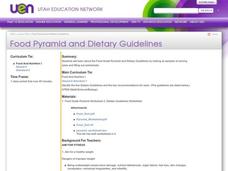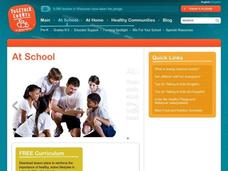Curated OER
Foods for Better Health
Students define biotechnology and discuss the economic impact of biotechnology. They also describe what a 1015 onion and a slow-softening tomato are and how they are produced. They examine the safety of genetically-engineered or altered...
Curated OER
What's on Your Plate?
Students analyze the calorie content of food. In this health science lesson, students discuss how excess calories affect our body. They write a healthy meal plan for their family.
Curated OER
Eating a Nutritious Lunch
Students identify the types of foods and snacks they eat for their lunch. In groups, they identify healthy foods along with unhealthy foods. They design a new lunch menu using only healthy food and identifying which food group they belong.
Curated OER
Broccoli
Students figure out rhythm notation for phrases describing the benefits of broccoli. They compose four-measure patterns using the rhythms of these phrases.
Curated OER
Food Pyramid and Dietary Guidelines
Third graders complete activities and worksheets to explore the Food Guide Pyramid and Dietary Guidelines .
Curated OER
Consumerism - Brand Comparison Lab
The student will have an opportunity for themselves to determine which brand they prefer by comparing national and store brands by their appearance, cost and flavor. They will be looking for the best economical value.
Curated OER
Food Pyramid
Second graders are introduced to the food groups on the food pyramid. Individually, they draw pictures of their favorite foods and identify which food group it belongs. To end the lesson, they discuss the importance of eating a variety...
Curated OER
Healthy Choice Shopping Frenzy
Students identify the four food groups. In this food pyramid lesson. students use pictures of food to determine what food group they belong to. Foods that are placed in the wrong place are discussed.
Curated OER
There Are Algae in Your House!
Students demonstrate that, although we sometimes can neither smell nor taste them, many ingredients in our foods and household products come from the sea. They also investigate food eat to determine algae derivatives they contain.
Curated OER
Food Pyramid Activity
In this food pyramid instructional activity, students fill in their choices in each of the food categories and estimate amounts eaten, then write their goals for food and activity for "tomorrow."
Curated OER
Food Pyramid Matching Game
For this food pyramid game, students match the right foods with their food group by drawing a line between the correct pairs.
Curated OER
Cooking Super Star Meals with Kids
Students explore the benefits of allowing and providing specifically designed age-appropriate cooking experiences for young children. They "cook" a variety of creative, healthy dishes designed for 3-5 year-olds to make and to help them...
Curated OER
Nurturing Green Thumbs at School
Incorporating a school garden into the curriculum cultivates many benefits.
Baylor College
Food Webs
Explore various ecosystems from around the world as your class discovers the interdependence of all living things. Using the provided sets of ecosystem cards, young scientists work in small groups building food webs to demonstrate the...
Curated OER
Consumerism
Students examine the techniques that companies use to sell their products. In this consumerism lesson students create an ad for a company and create a handcrafted butterfly.
Curated OER
Your Energy In
Help your youngsters make considerations about what they eat. Use this lesson as a jumping-off point to discuss dietary guidelines, the food pyramid, and major food groups. This creative lesson grabs youngsters by talking about what they...
Curated OER
Your Energy In
What are Dietary Guidelines? What are the basic principles of a sensible healthy diet? What do variety, balance, and moderation have to do with eating healthy. What are the food groups? There are a couple of activities in this lesson...
Baylor College
Do Plants Need Light?
Turn your classroom into a greenhouse with a lesson on plant growth. First, investigate the different parts of seeds, identifying the seed coat, cotyledon, and embryo. Then plant the seeds and watch them grow! Measure the new plants...
Baylor College
What's Is Soil Made Of?
It's time to roll up those sleeves and get a little dirty in the second lesson of this series on the science of food. Investigate where plants and animals get the minerals they need to live in this two-part exploration of soil. First,...
Baylor College
Healthy Snacks
Assess your pupils' ability to identify healthy food choices in the final lesson of this series on food science. Given five different food labels, young nutritionists will rank them from most to least healthy, supporting their choices...
Curated OER
Home Living/ Daily Living: Food Pyramid
What did you have for lunch? Did it contain all four food groups? Help your special education class make good food choices and recognize foods in each of the four food groups. They look at images and discuss the foods on the food pyramid...
Curated OER
Math in Science-Knowing the Calories You Take In!
I can burn off one scrambled egg in 30 minutes of walking? Explain how we daily consume and burn calories using this fun worksheet, which breaks down basic foods and activities into kilocalorie equivalents. Nutritionists calculate the...
Curated OER
What Can I Do?
Pupils identify ways to handle conflict. In this conflict resolution lesson, students brainstorm times when they had a conflict with a friend. Pupils develop a strategy to deal with conflicts in the future, such as talking it through or...
Curated OER
Training Table Race
Students investigate the role of the carbohydrates food group in sports performance. The difference between simple and complex carbohydrates, and the performance of cardiovascular activities form the focus of the lesson.























